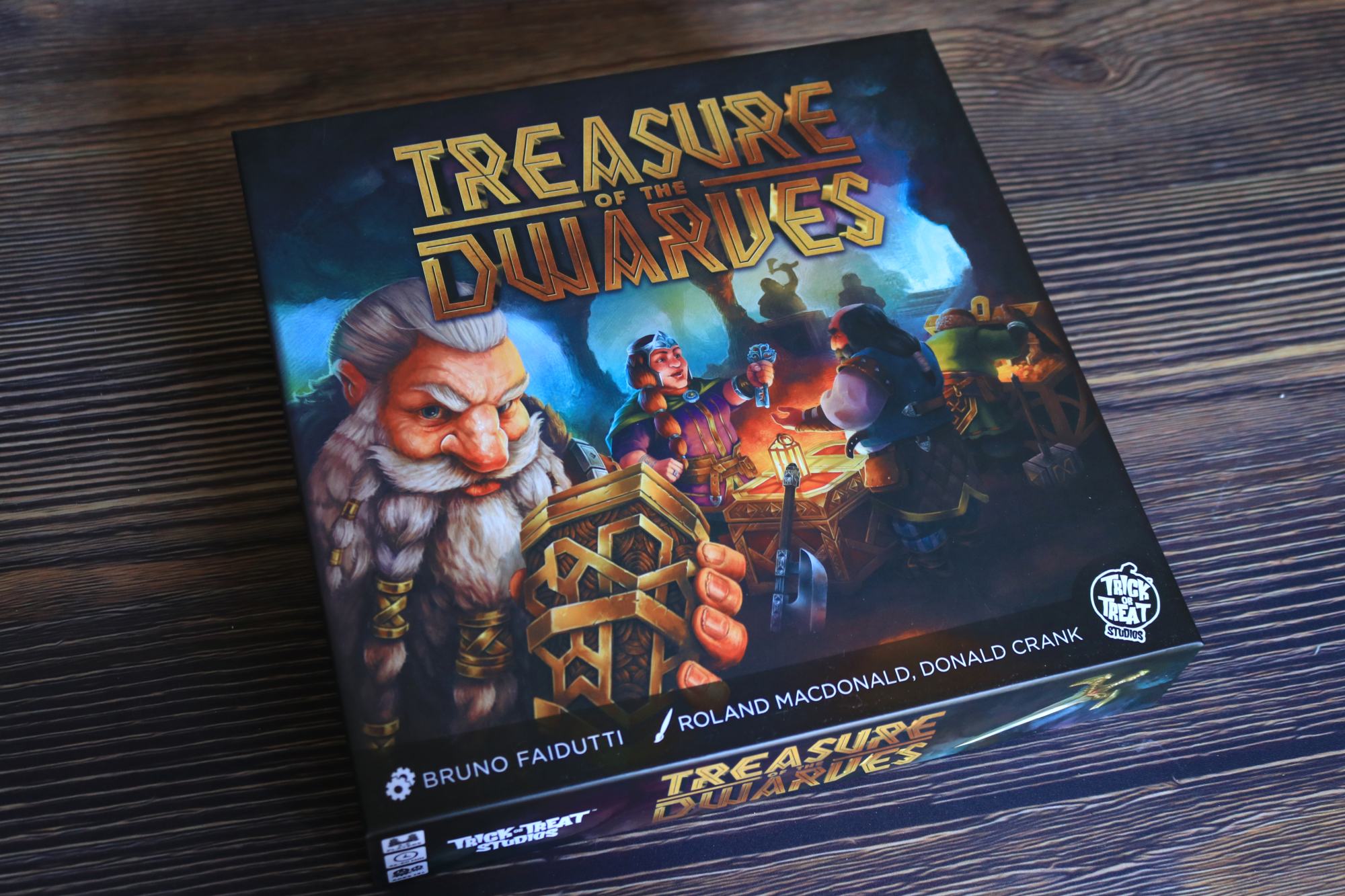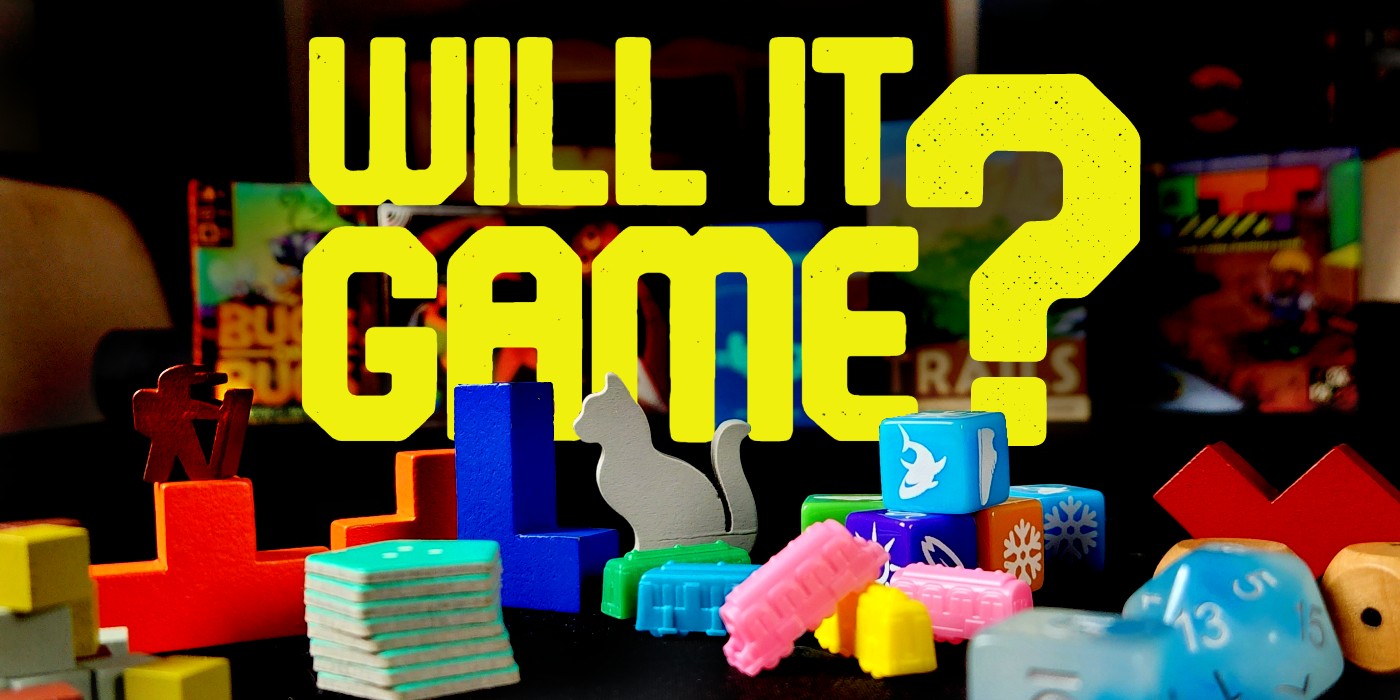Deep in the mines, dwarves are gathering the most precious treasures to trade and auction off among the community. Treasure of the Dwarves is a bidding and set collection game from designer Bruno Faidutti, published by Trick or Treat Studios. Let’s head into the mine and see what this game is all about.
The Sales Pitch
Players will start each game with a hand of cards, a player screen, a secret chest, starting coins, and five random gems. Each round a different player will be the “seller,” which is designated by a token that is passed to the player on the left after each turn. In a four player game there will only be a single seller. In any player count above that, two seller tokens will be in play at the table.
As the seller, you’ll place a card from your hand up for auction. Everyone else will submit bids for that card by placing coins and/or gems into their secret chest and sliding it toward the seller. They should be cautious not to shake the chest, which could possibly give away the contents that rest inside. If there are two sellers, players can choose which of the two cards they feel like bidding on with the contents of their chest.
Treasure of the Dwarves puts the seller(s) in a position of power as they accept or reject the bids of their fellow dwarves. The seller can look at any of the secret chests they want, with a couple of caveats. The seller cannot shake the chest to get information about what could be inside. And, once a player looks inside and passes to another secret chest, they cannot go back to accept that bid.
Evaluating the Field
Players have to evaluate their opponents needs before they ever open a secret chest. Who needs this card the most? Who might find this card valuable? Is someone at the table trying to catch me off guard? You can put any number of gems and/or coins in the secret chest when bidding. Or, you can put nothing at all.
Once the seller accepts a secret chest, they add the new items behind their player screen and pass the secret chest and auctioned card to the winning player. Most cards will be added to the players display which everyone at the table can see. Some cards will have an “instant” icon which means that they have to trigger an effect immediately after winning the card.
As players win new cards, they build out their display and begin revealing the strategy they are aiming for. Some cards score in sets or compound points. Others can be counted as specific colored gems or boost the value of specific coins the player is holding.
Play continues around the table with a new seller(s) until all players have three or fewer cards in their hand.
A Gem of an Experience
Players collect end game points through cards, card effects, coins that are worth their face value, and by collecting sets of gems. Gems come in five different colors and the player with the most gems in each color will receive fifteen points. You can also earn ten points for each set of the five different gem colors.
Treasure of the Dwarves is a very straight forward bidding game that has a really fun psychology behind it. Players are always looking to gain a new card by giving up as little as they can. You cannot outright tell the seller what your box contains, but you are welcome to hint that the box “has a great offer” or “has something important inside.”
It’s so much fun to put a card up for auction that would be a huge amount of points for a specific player. Immediately, players will dump coins and gems with the hope of keeping that card away from another player. This game thrives on getting the right players around the table who are willing to undercut and double-cross others at the table.
While the mechanics and gameplay are simple, the variety of cards are what make this game shine. Treasure of the Dwarves is a very mean game if it’s played properly. Underhanded dealing and using cards to ruin another player are encouraged. Players need to know this going into the game. This isn’t a game where players need to take things too seriously.
Final Thoughts
Going into this review, I had some hesitations about playing this game at a high player count. Our first couple of games were great at four players. Eventually we had seven players around the table and found that having two sellers at one time went really smooth. The game plays in right at an hour no matter how many players are at the table, which is a real feat.
The most disappointing part of Treasure of the Dwarves would probably be the tiny player screens. The secret chests feel nice and seem like they’ll hold up with a lot of play. However, the player screens are small and hide next to nothing, especially at the higher player counts. Cards have a nice linen finish and the gems and cardboard coins are pretty standard. This is a game that would have benefited from player screens 25-30% larger.
Treasure of the Dwarves takes a simple ruleset and let’s players build a fun experience based on who shows up at the table. This game is ripe for creating alliances, undercutting the player who has the best collection, and stealing that one last card that your opponent was looking for. Thankfully, dwarves have tough skin, because Treasure of the Dwarves is a game that can be very cutthroat.
Treasure of the Dwarves is now available at your local game store, from the Trick or Treat webstore or online through Amazon today.
This game was provided to us by the publisher for review. Read more about our review policies at One Board Family.
Highs
- Variety of cards and effects in the game are excellent
- Secretly accumulating points in coins and gems
- Outbidding and wrecking an opponents strategy is fun
Lows
- Player screens are small and not great quality
- Some cards can be too mean for some players taste










